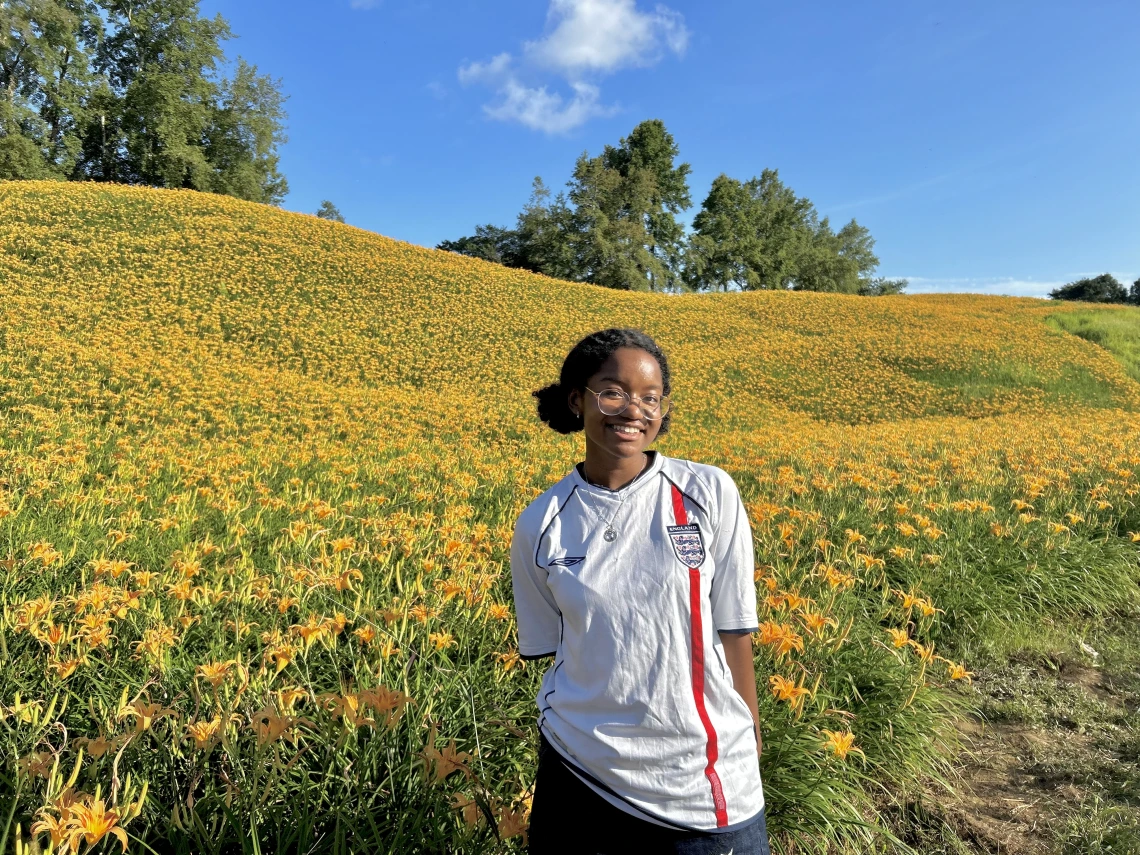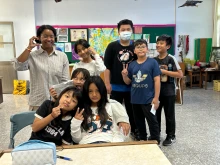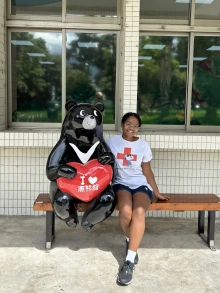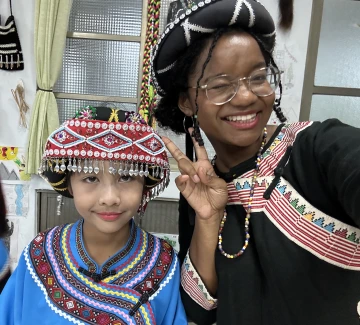Fulbright Q&A - Hanna Nkulu


Hanna Nkulu graduated from the University of Arizona in spring 2024 with a B.S. In Neuroscience and Cognitive Science and a minor in Chinese language. She spent this last year in southeastern Taiwan, where she worked as an English Teaching Assistant through the U.S. Fulbright Program. With opportunities in over 140 countries, Fulbright supports scholars through English teaching opportunities abroad, as well as grants for study and research, and is sponsored by the U.S. Department of State.
Hanna shared about her memorable experience in Taiwan as an ETA this past year, her Fulbright application process, growth areas and challenges, and the impact of connecting with community and cultures across the globe.
Why did you decide to apply for Fulbright?
I was interested in applying for the Fulbright program due to interests in international education and cross-strait relations. I felt that the English Teaching Assistant program was well-suited for me because I spent three years of undergrad teaching local high school students Mandarin Chinese through the TRIO/Upward Bound program, so I thought it would be an exciting opportunity to switch things around and teach Taiwanese elementary school students English. I had known about Fulbright for a long time because I had also previously held an interest in working for the State Department's Bureau of Educational and Cultural Affairs, so when the applications opened in spring of my junior year, I immediately set up an appointment with the Office of Nationally Competitive Scholarships in order to best prepare for the application.
My dad is from the Democratic Republic of the Congo but my mom is from the Philippines, so Tagalog is a language that I have had a lot of exposure to while growing up. While preparing for my application, I learned that Filipinos can trace their roots to Austronesians in Taiwan, which makes for linguistic similarities between Tagalog and some indigenous languages in Taiwan. When I found out that I had received the Fulbright scholarship, I was super elated. I felt excited about the prospect of going abroad and experiencing something new, as well as sharing my life in the U.S. with students in Taiwan.
What was a typical day like for you as an ETA in Taiwan?
I lived in Yuli Township, which is the largest township in the area. I taught 3rd grade to 6th grade English classes at one of the two large elementary schools in town. My school had around 300 students and I feel very proud to say that I knew all of my students by (English) name towards the end of the school year, as I loved being able to work and share experiences with them throughout the year. A typical day as a Fulbright ETA in Taiwan starts with breakfast at one of the local 燒餅 (shaobing) or 包子 (baozi) shops, where I would either have a traditional Taiwanese breakfast sandwich with egg and pork in a baked sesame bread or a steamed pork bun in the morning. I liked to come to school before 8:00am so I could set up in my English classroom and review the materials I put together for the day's lessons. My favorite days were the ones when I taught fifth grade. My co-teacher and I had a really great relationship and we worked very well together at the front of the classroom, and our students were always very funny and uniquely enthusiastic about using English, even outside of the classroom. I ate school lunch at school, where they often served traditional Taiwanese foods like pork, rice, and vegetables. Occasionally, we would even have milk tea offered as the daily soup, which brought joy to both the students and myself. I typically had at least two to four classes per day with a total of eighteen English classes per week.

On Fridays, I also took Mother Tongue Class (母語課) with my Bunun fifth grade students. This class allows for indigenous Bunun students to learn their language and culture with a local teacher. We learned a lot of traditional songs and made many traditional crafts using items like millet seeds, beads, and pieces of wood.
After school, I enjoyed biking around with my fellow Fulbrighters and going out for dinner (likely at a restaurant owned by one of our student's families). The town I lived in was quite small, so you could easily bike from one end of town to the other within 20 minutes. It was also extremely common to run into your students outside of school, which made my days pretty exciting because I never knew who I would run into while running errands on the weekends. Despite being a rural town, we enjoyed exploring everything the area had to offer by spending our weekends swimming at the local waterfall, heading to the beach, hiking around the mountains, and volunteering on local farms.
You just completed the school year in Taiwan. What were your biggest takeaways: highlights, challenges, etc?

One of the biggest highlights of the year would have been making so many wonderful friends and being exposed to unique aspects of Taiwanese culture and history. The Fulbright program brings together so many people from all across the US and I really valued that aspect of the program as even within my cohort, myself and a friend from Colorado were able to exchange our experiences growing up in the southwest with stories from our friends from the northeast. I feel like our geographical diversity made for many fun conversations among ourselves and presented a great way to discuss with our Taiwanese coworkers and friends how diversity in the U.S. is further than race or ethnicity.
One of the biggest challenges that I faced throughout the year was co-teaching! I had previously taken undergrad courses that were co-taught by my professors and while I never thought of it as a piece of cake before, I realize now how much of a skill it really is! This was something that illuminated many strengths and weaknesses in my teaching abilities and sometimes caused me a bit of frustration throughout the year due to cultural differences about teaching and pedagogy in general. I was ultimately able to overcome these differences and I now consider both of my co-teachers as dear friends of mine.

How did ONCS support you during the application process?
I was extremely grateful for the support that ONCS gave me during the application process. I wouldn't even have submitted my application on time had it not been for Valeria! I started early in the application process by setting up a meeting with her as soon as the applications opened. She allowed me to take part in the Summer Fellowship Application Development Program before my senior year started so that I would have regular deadlines to write up drafts for my application materials to be reviewed and revised. I was extremely grateful for that program because I ended up feeling quite proud of the application I put together by the end of the summer, so much of my stress didn't carry over to the beginning of the school year. I did, however, nearly miss the campus deadline! It was really all thanks to Valeria who personally gave me a call the evening that it was due to ask about my progress on submitting, because without that phone call, I absolutely would have submitted my application weeks later. My biggest advice to students applying for Fulbright, especially those that are applying through the university, would be to be aware and prepared for the campus deadline, as it comes much quicker than the official Fulbright program deadline!
Is there anything else you would like to share with us or would like us to know that we didn't ask about?

Something really touching that I took away from this year would be that one of the reasons why I chose my specific placement in Taiwan was because I wanted to try life in an area that looked quite different from my life in Arizona. I wanted to experience the Taiwanese countryside and live in an area with low English profiency due to personal goals of wanting to improve my Chinese profiency and challenging myself in a new situation.
Something unexpected that I discovered throughout the year though was that life in Southeastern Taiwan shared many similarities to life in the Southwestern United States. Both areas were surrounded by the mountains and once you left the big cities, you were greeted by scenic roads through incredible natural landscapes that extended in multiple directions. The local community was uniquely diverse, with many of my students being trilingual by speaking Chinese with their teachers and peers, practicing English with me, and using Bunun, Amis, or another indigenous language at home with their families. Signs for the library and post office as well as classrooms at my school were posted in Chinese, English and Amis, which reminded me of some signage around the University being in English and Diné.

Community events in my town often highlighted local Bunun and Amis performances, artists, and foods, and everyone I met was both incredibly proud of and comfortable in their indigenous identity. While I am not indigenous, I felt that this aspect of life in Yuli reflected many aspects of what I love about life in Arizona. Arizona is such a unique piece of the United States because there are so many cultures baked into the Sonoran desert through the various tribes that call this area their homeland, as well as having a large Mexican population in the state. Being able to take 母語課 (Mother Tongue Class) with my Bunun fifth graders and be a part of our school's Bunun singing group presented an opportunity for me to learn more about Taiwanese indigenous history, Austronesian cultures and migration, and the importance of tradition and cultures in our society.
I enjoyed practicing Bunun vocabulary with my students and learning that some Bunun words were often the same as Tagalog words, which made me feel more connected to my community in Taiwan. With my Bunun teacher, I loved being able to share how my life growing up in Arizona and US history in general has been influenced by Navajo communities and other indigenous peers. We often spent time together sharing stories of Indigenous history in Taiwan and the US while working with millet seeds and beads in order to make necklaces for our students. I greatly cherish all of the time I spent studying Bunun language and culture while in Taiwan, as it brought me closer to my coworkers and closer to my students.
--
The University of Arizona campus deadline for Fulbright is September 7, 2025. For more information about the campus process please contact Valeria Quijada.

